OLD ENGLISH GRAMMAR. THE NOMINAL SYSTEM.
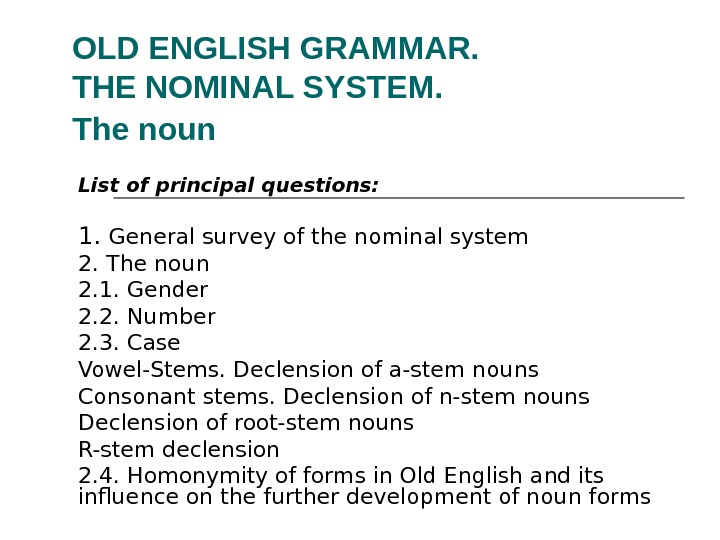
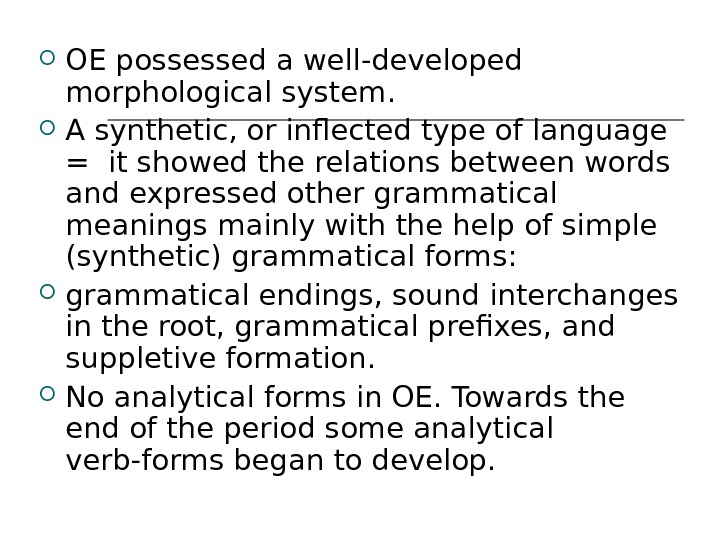
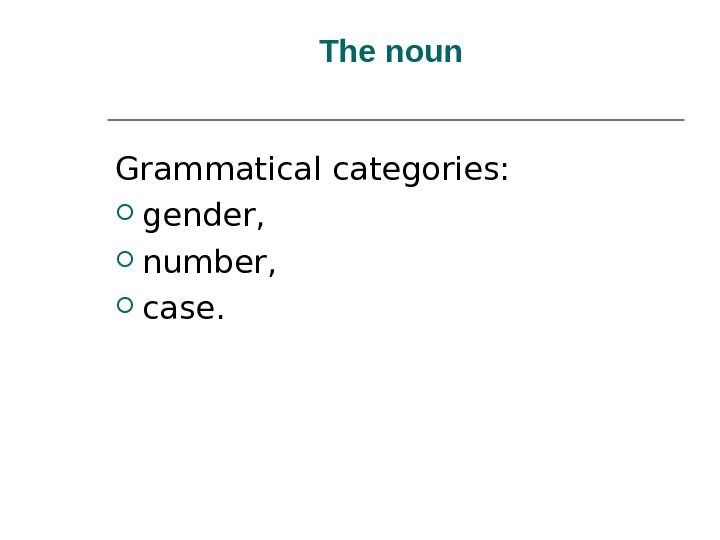

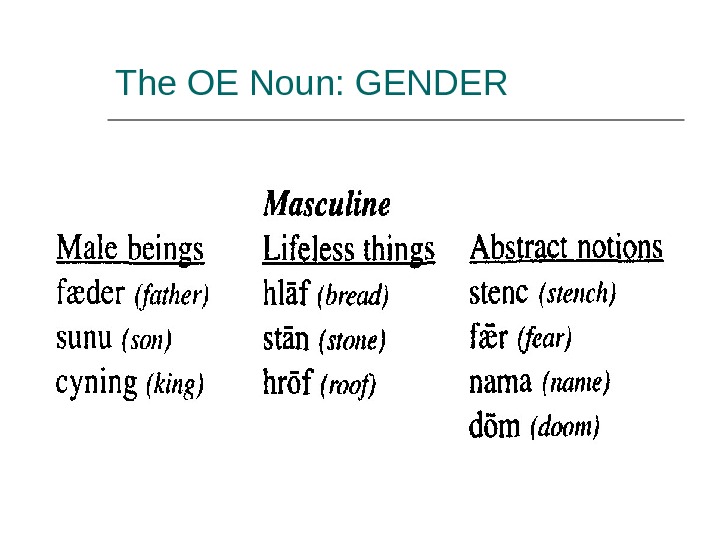

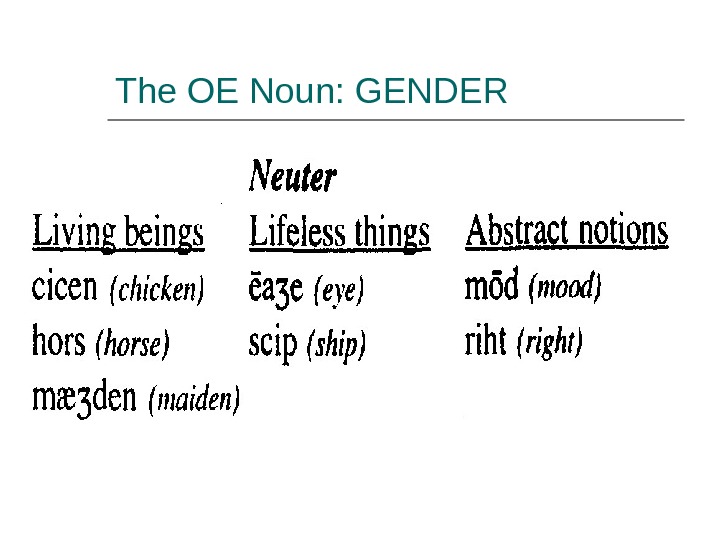
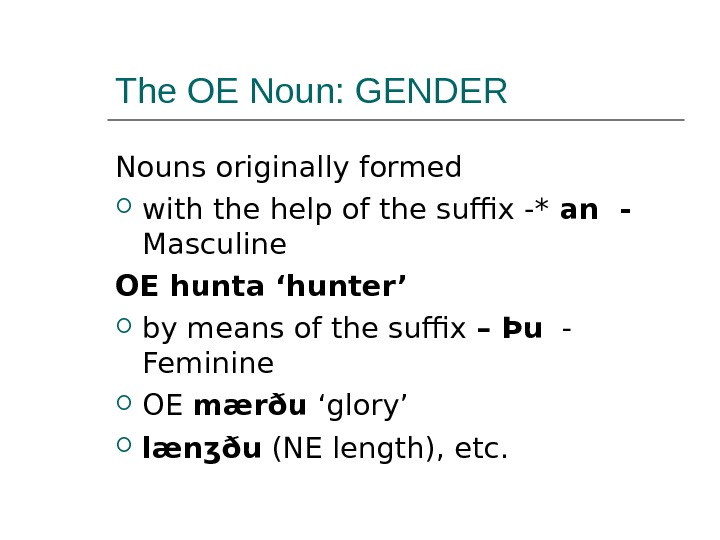
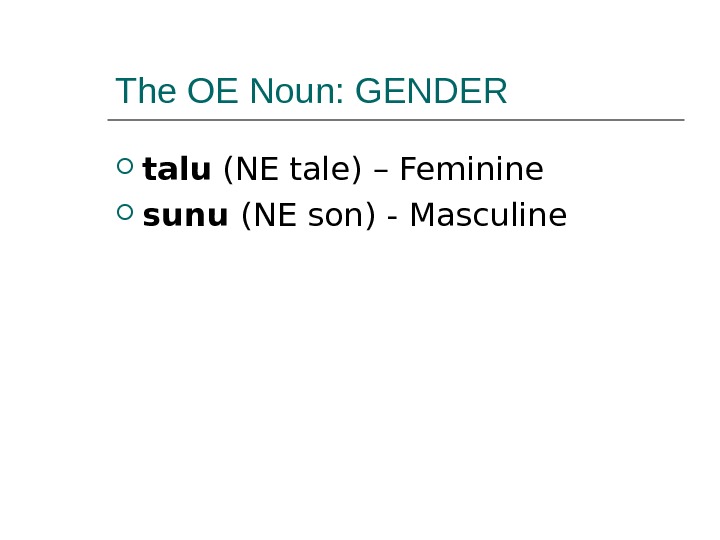
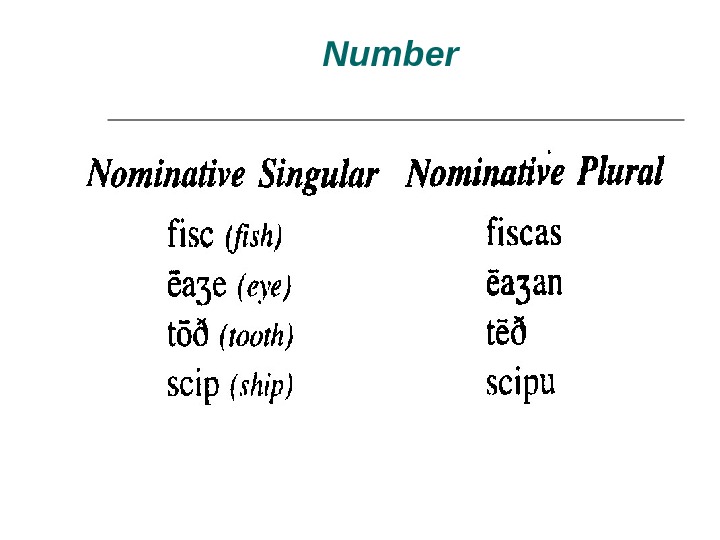

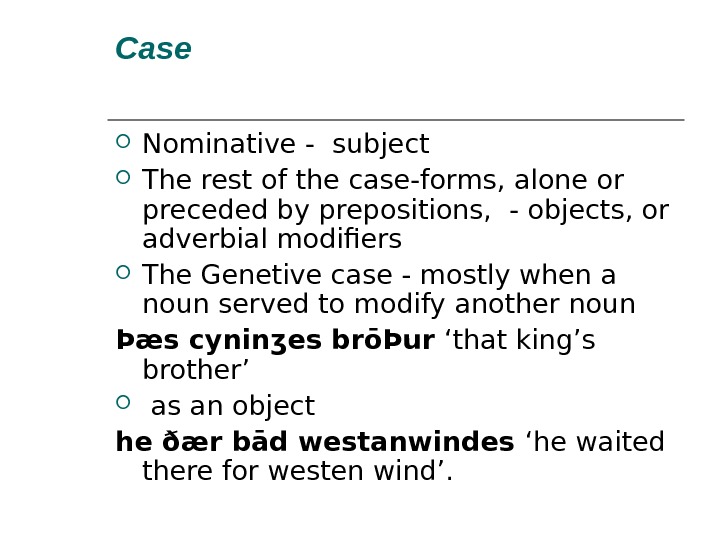
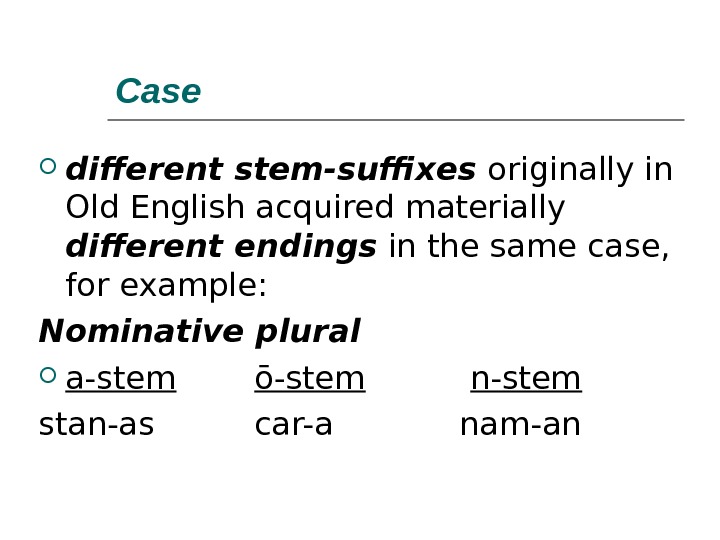

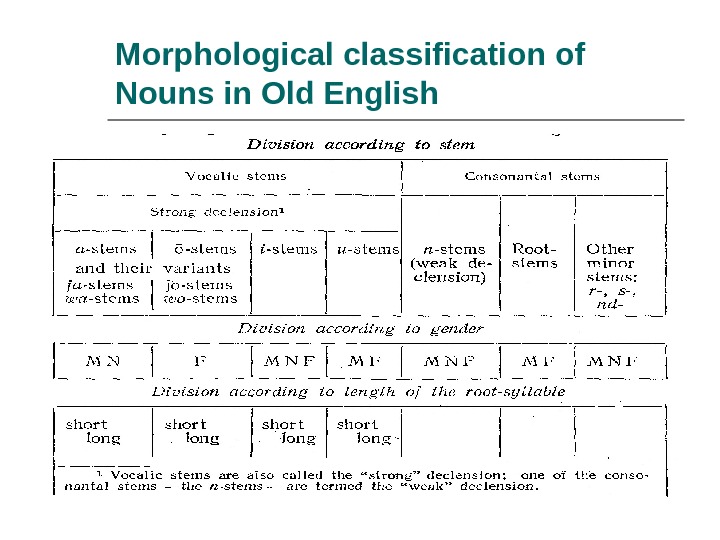
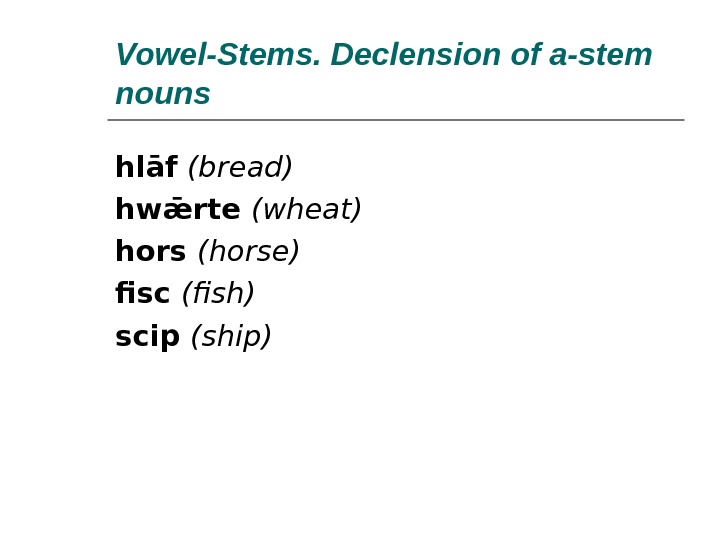
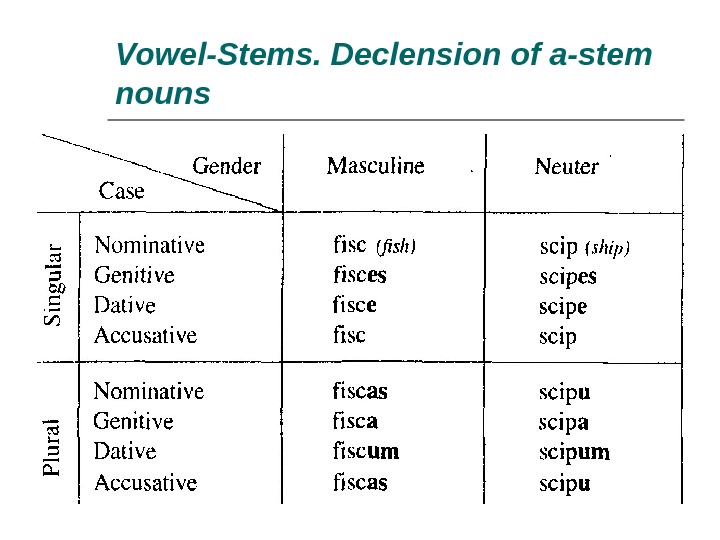
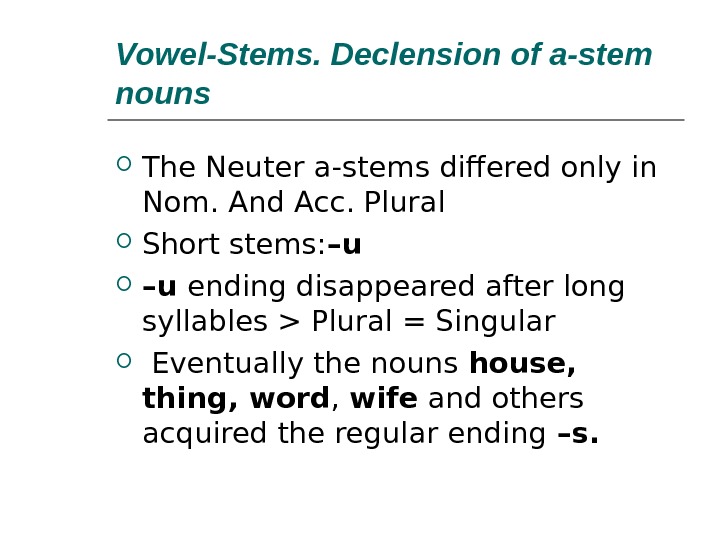
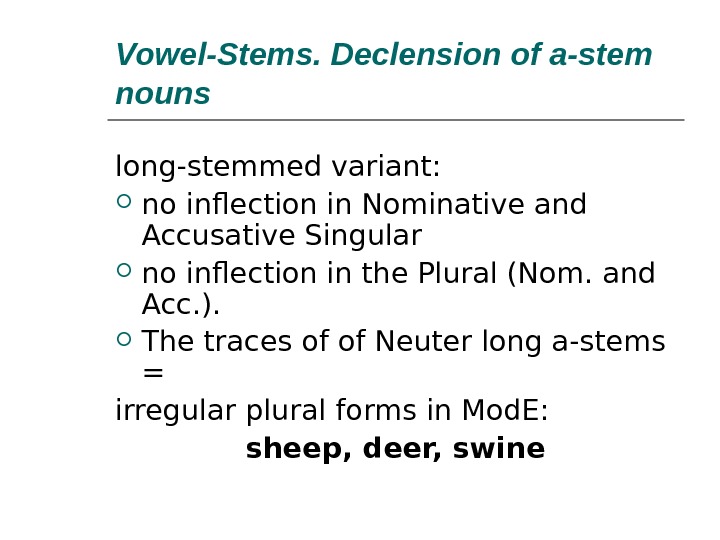
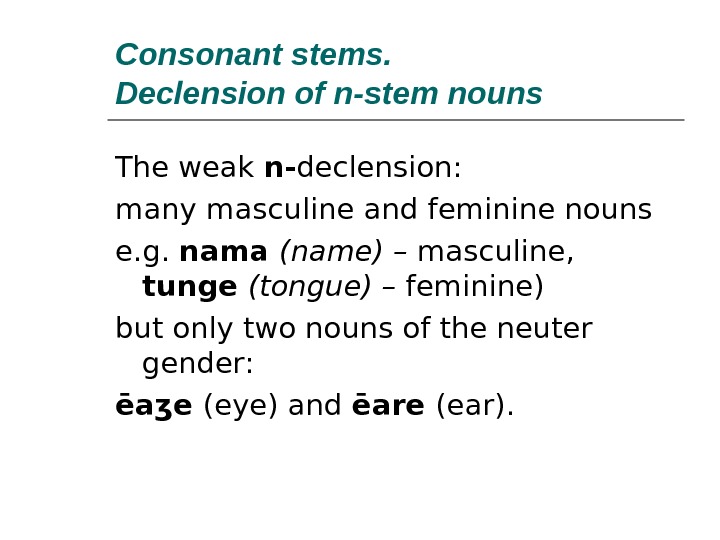
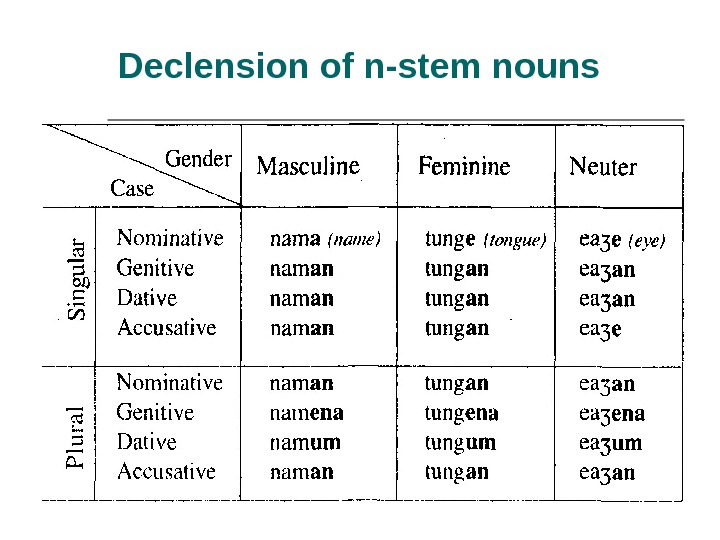
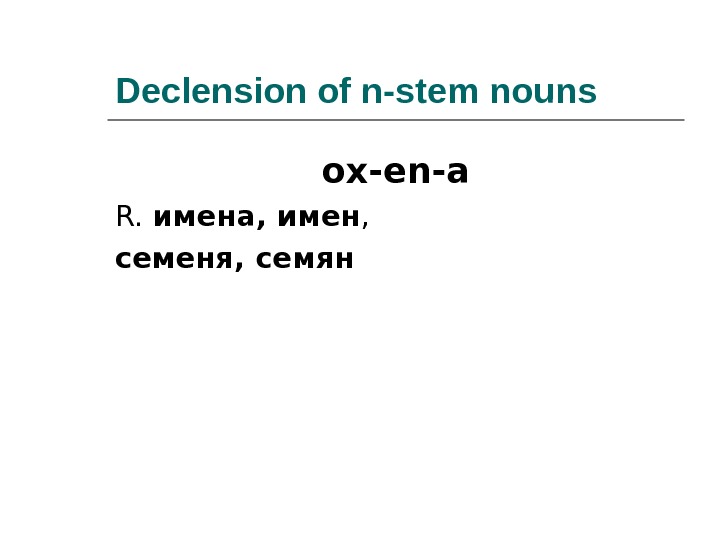

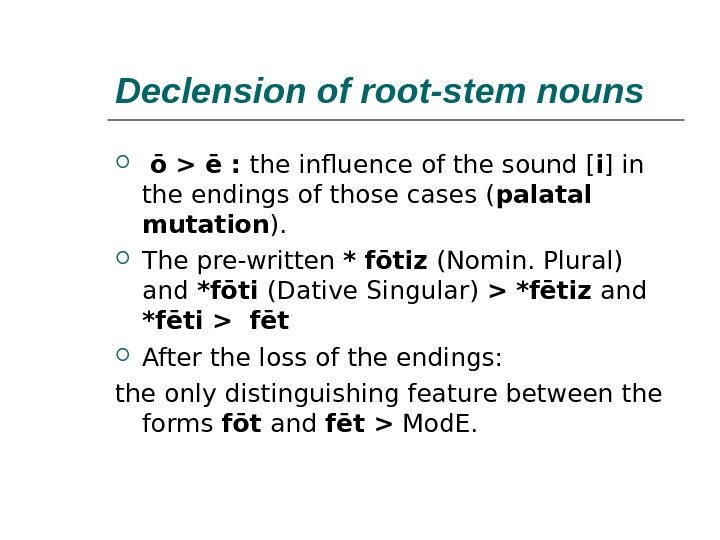
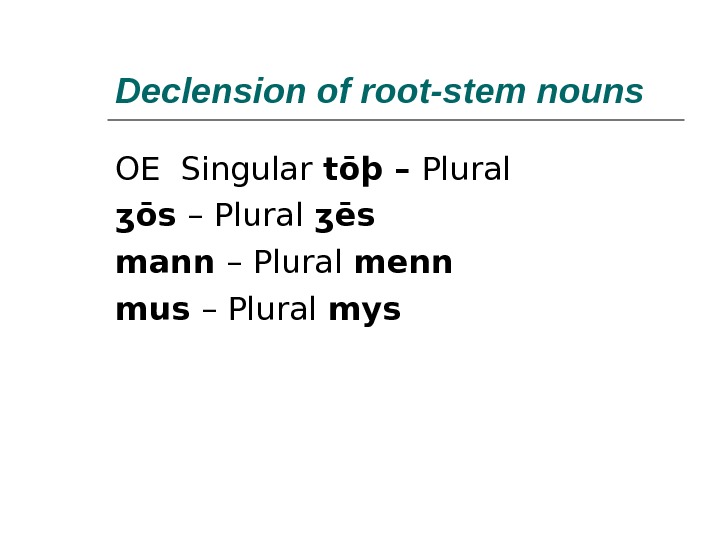
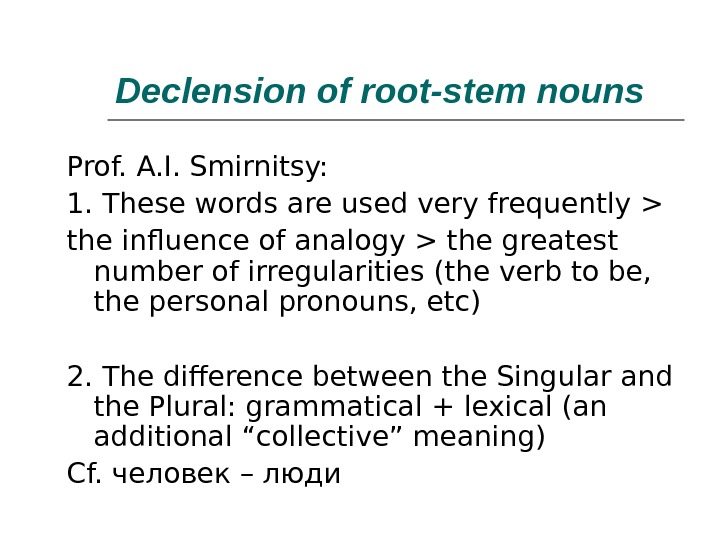
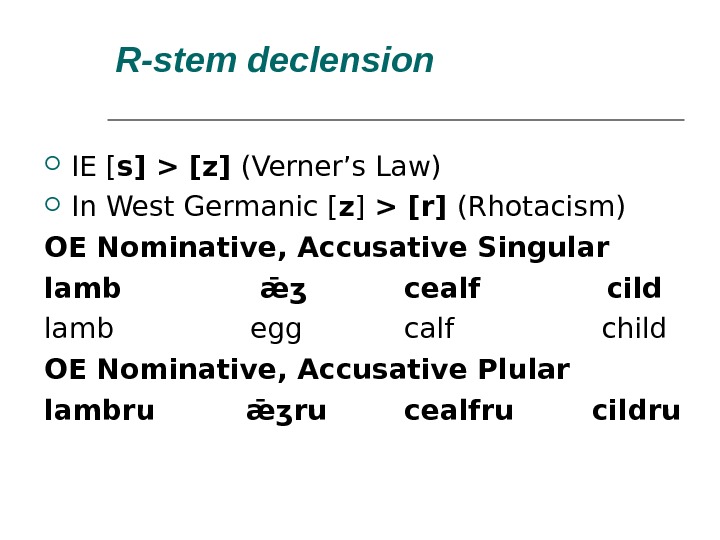
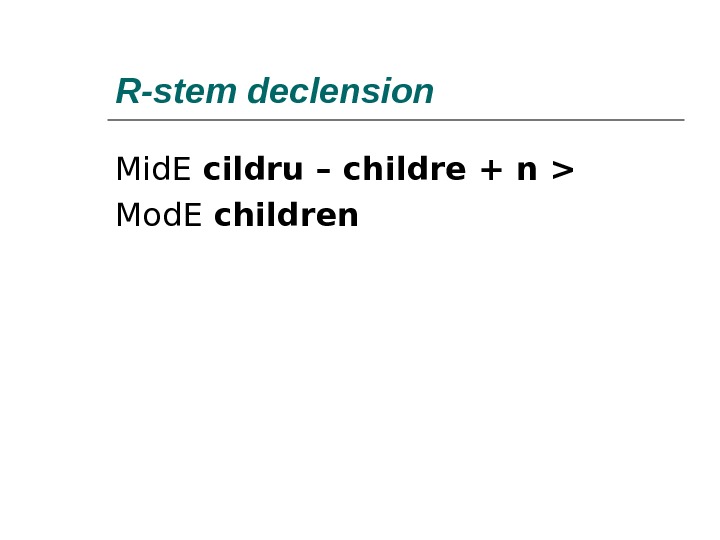
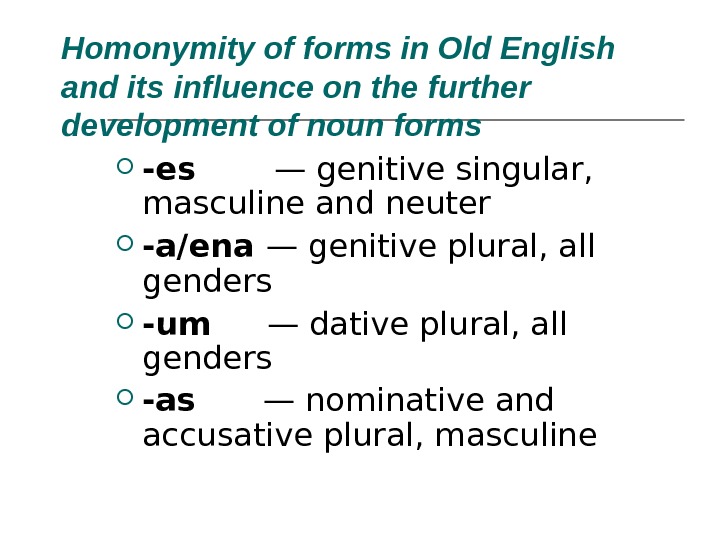
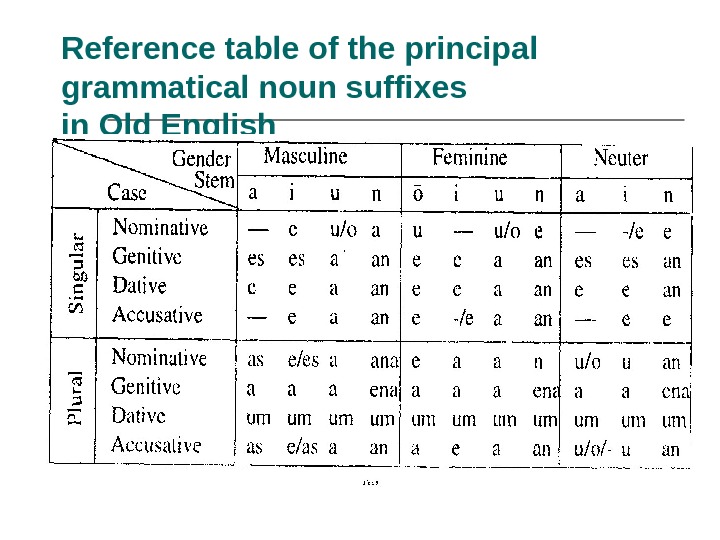

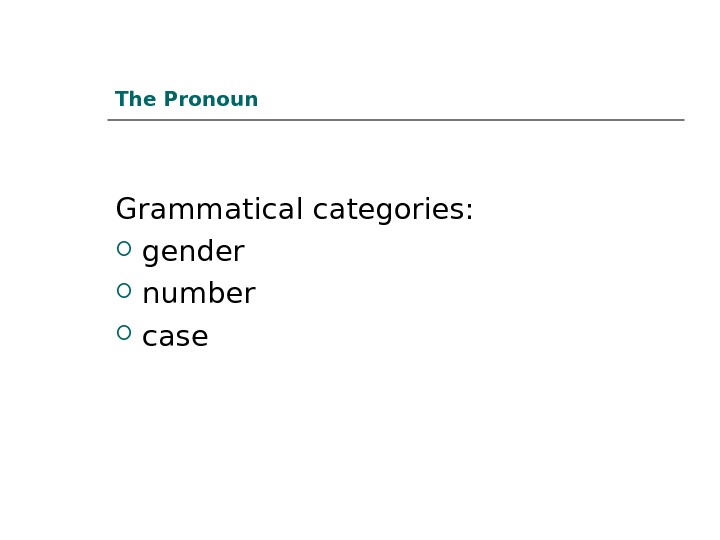
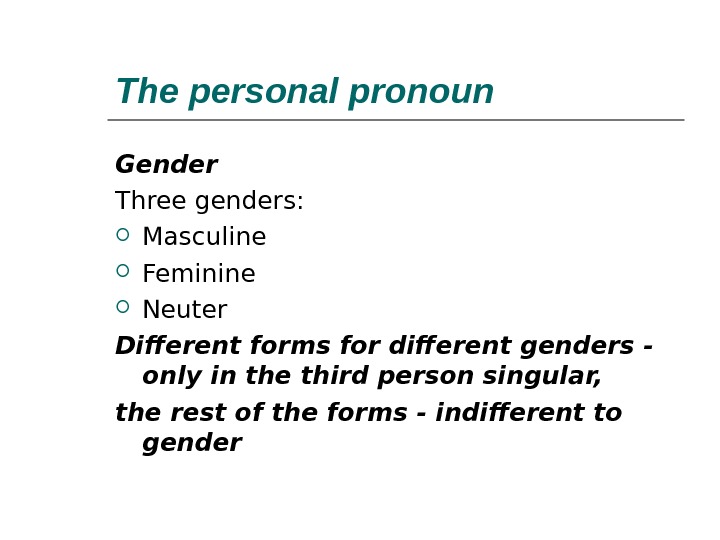
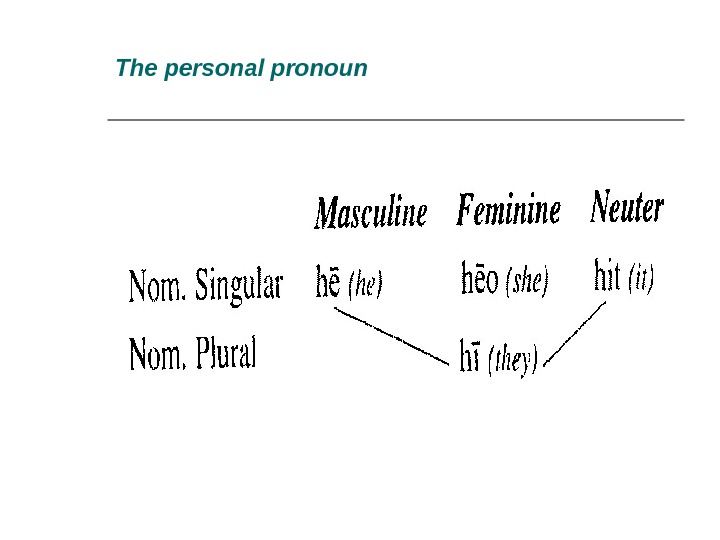
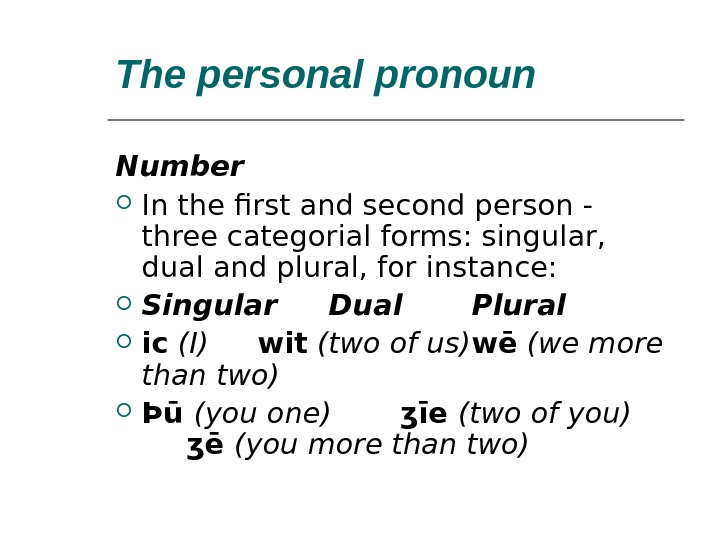
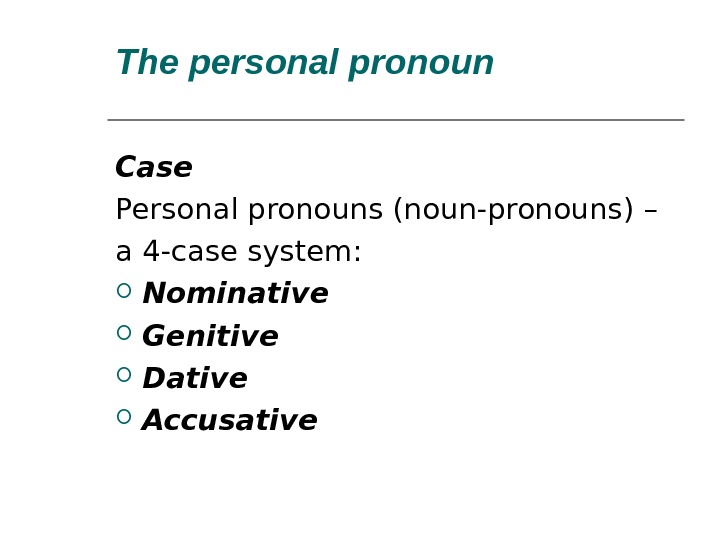
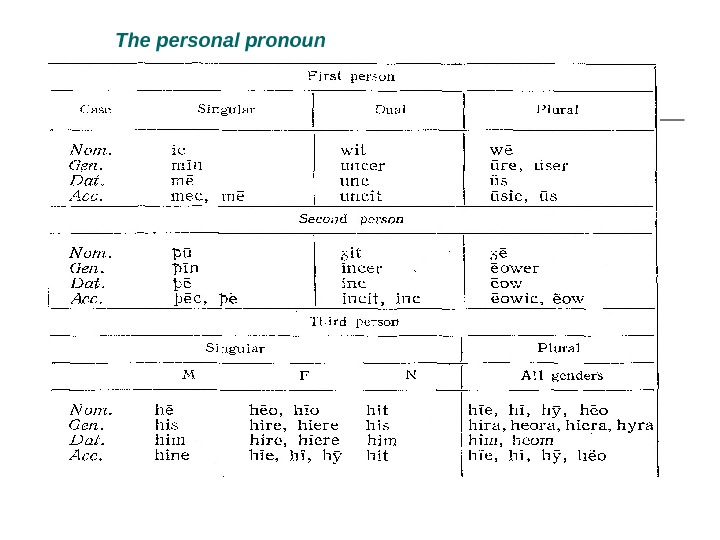
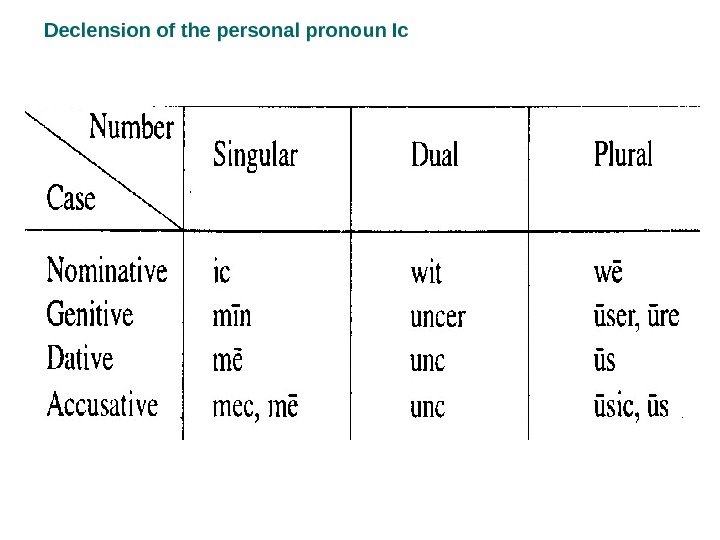
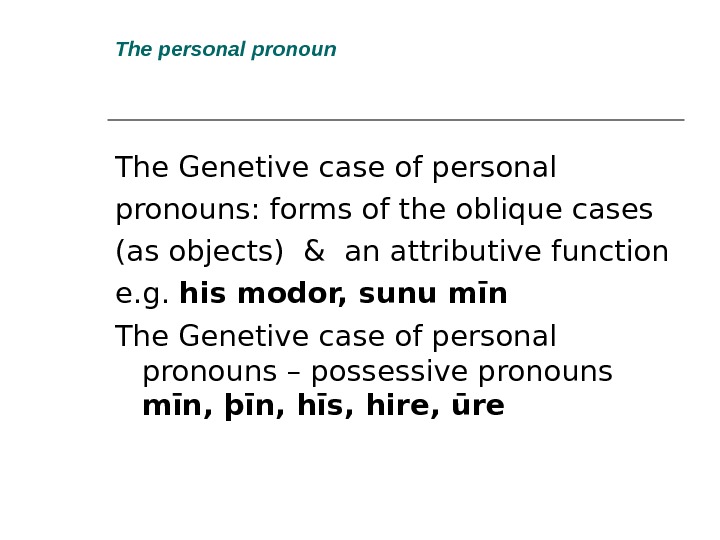
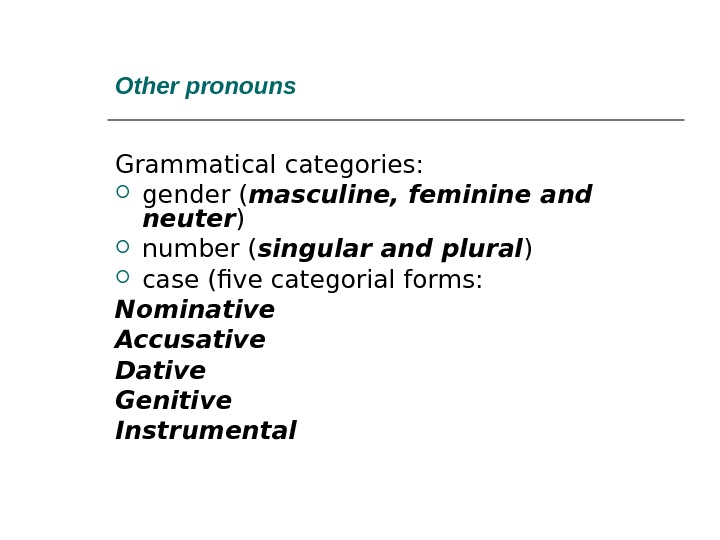
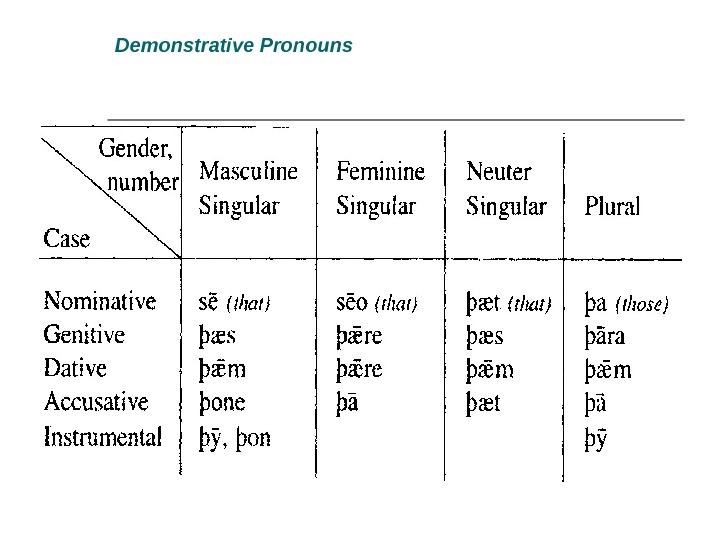
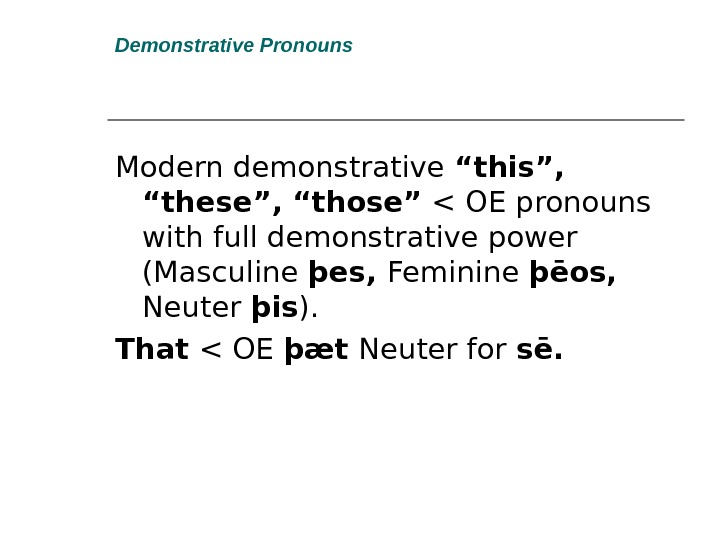
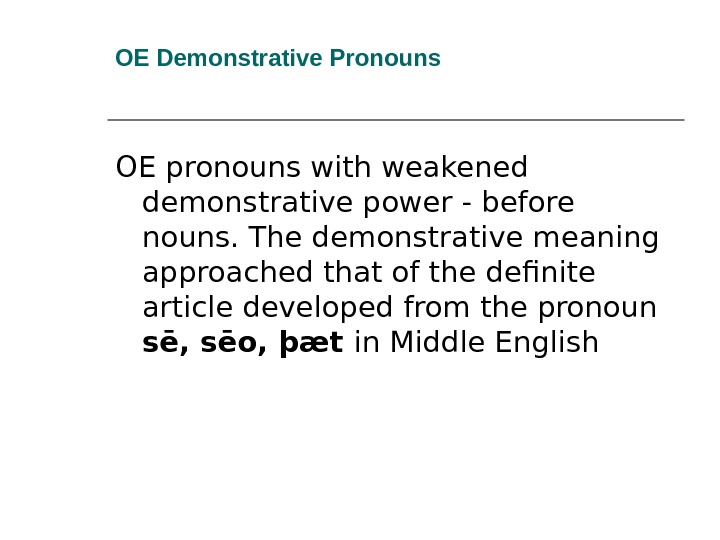
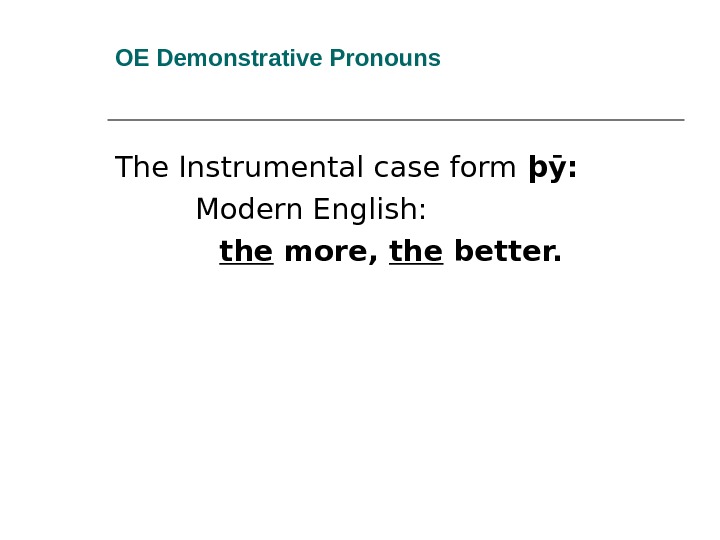
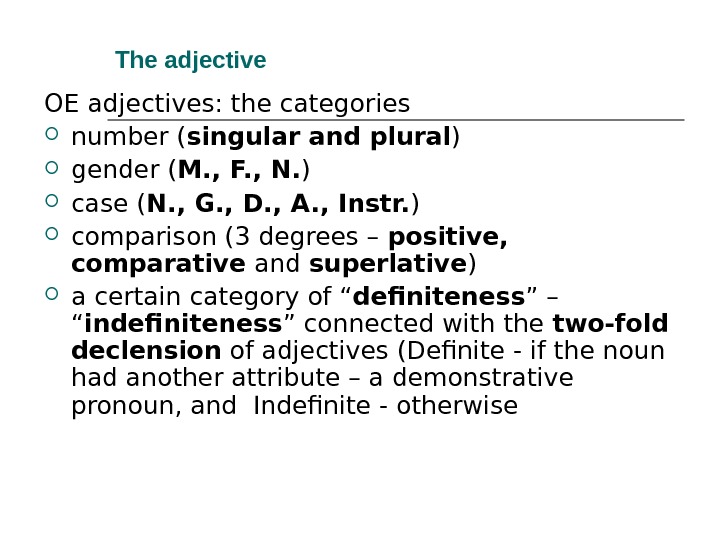
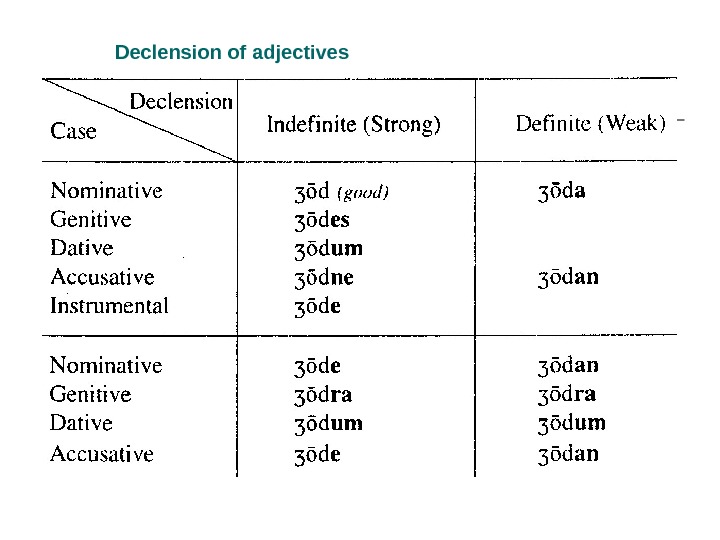
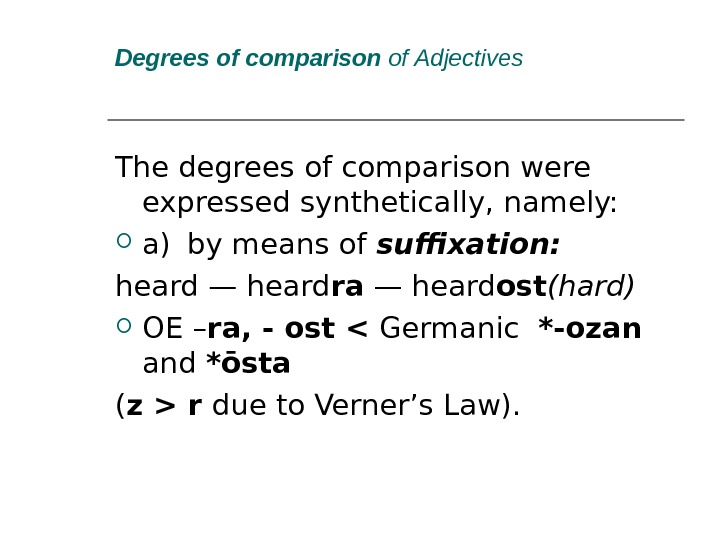
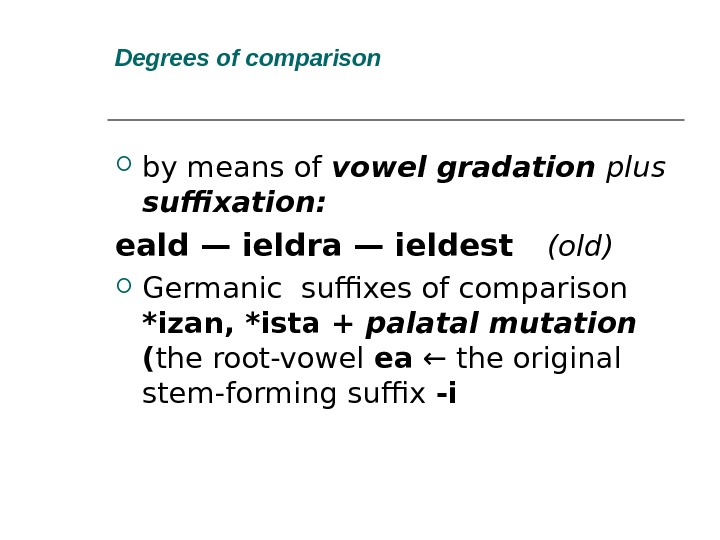
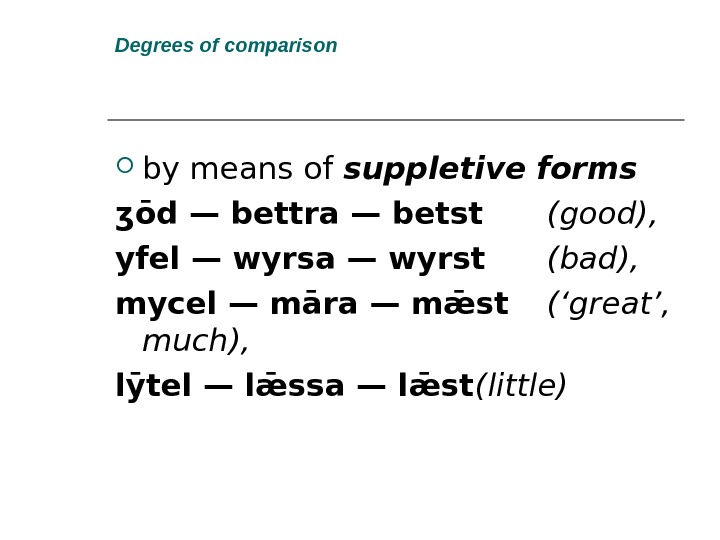
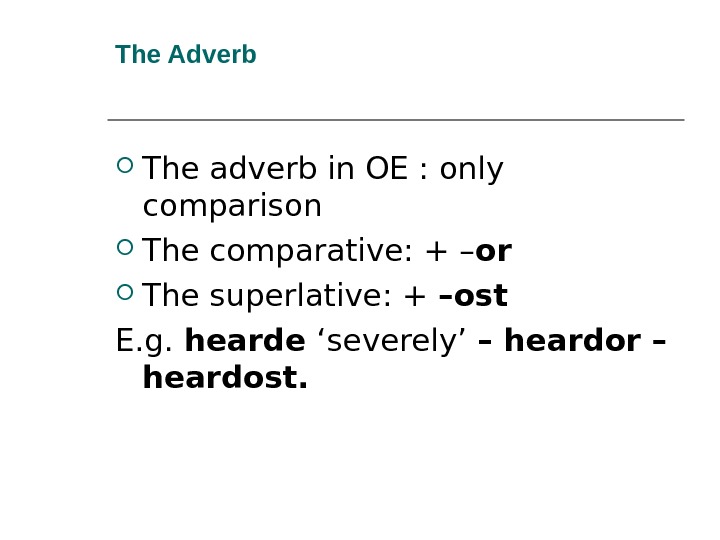
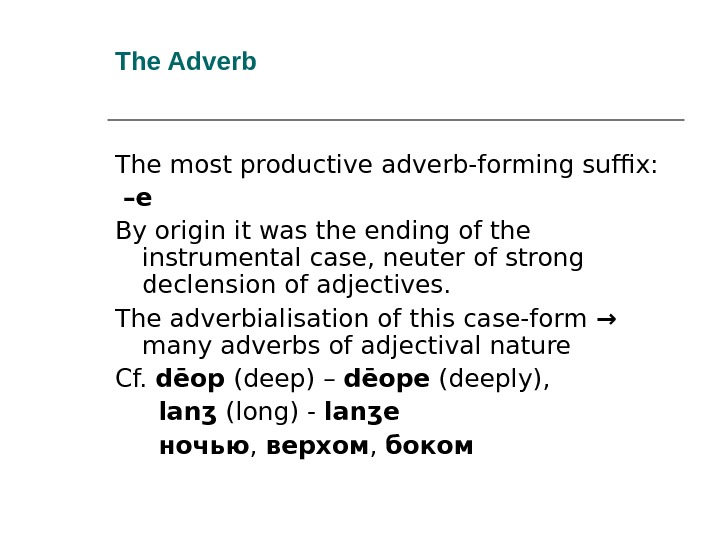
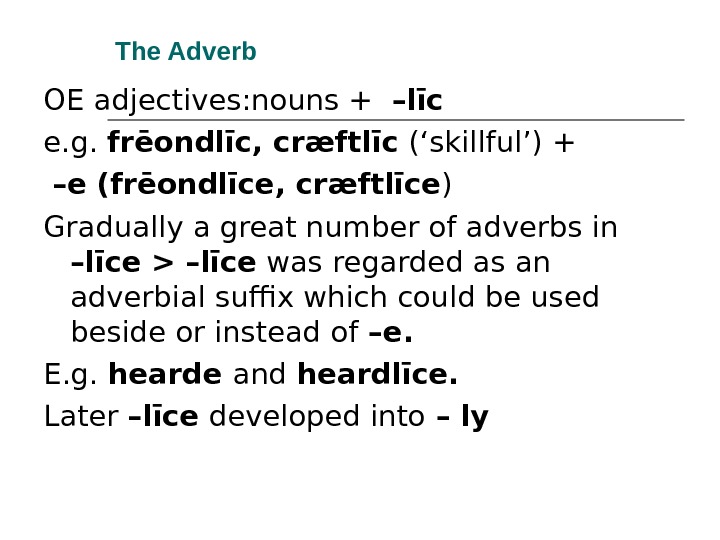
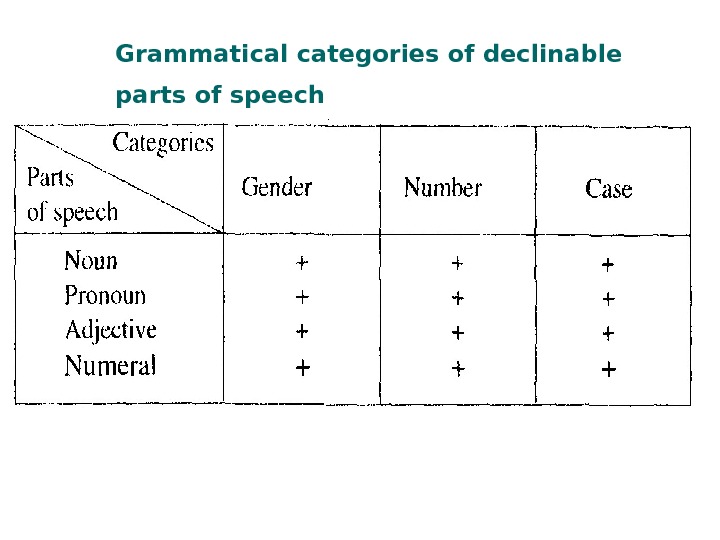
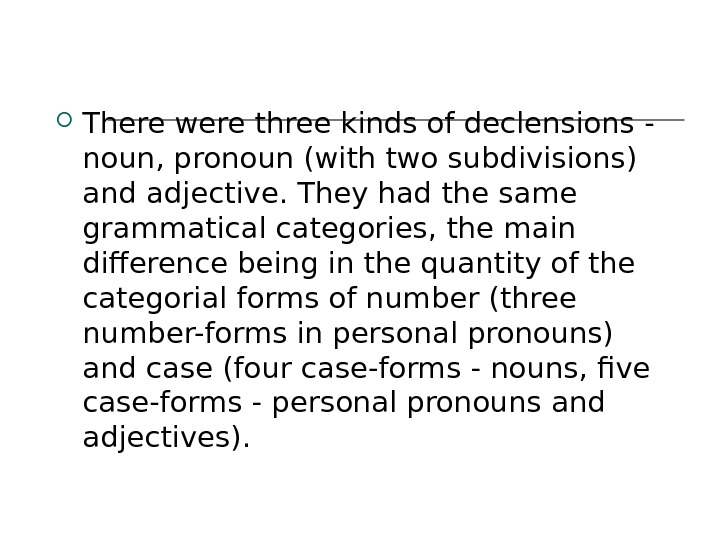
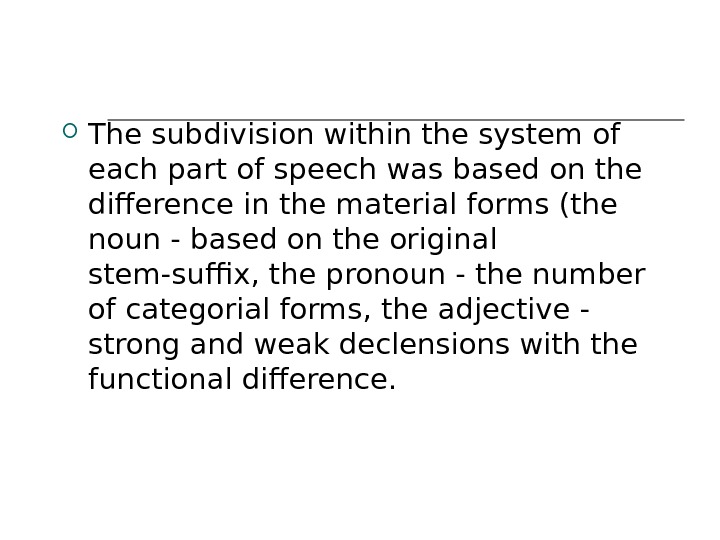
- Размер: 2.1 Mегабайта
- Количество слайдов: 55
Описание презентации OLD ENGLISH GRAMMAR. THE NOMINAL SYSTEM. по слайдам
 OLD ENGLISH GRAMMAR. THE NOMINAL SYSTEM. The noun List of principal questions: 1. General survey of the nominal system 2. The noun 2. 1. Gender 2. 2. Number 2. 3. Case Vowel-Stems. Declension of a-stem nouns Consonant stems. Declension of n-stem nouns Declension of root-stem nouns R-stem declension 2. 4. Homonymity of forms in Old English and its influence on the further development of noun forms
OLD ENGLISH GRAMMAR. THE NOMINAL SYSTEM. The noun List of principal questions: 1. General survey of the nominal system 2. The noun 2. 1. Gender 2. 2. Number 2. 3. Case Vowel-Stems. Declension of a-stem nouns Consonant stems. Declension of n-stem nouns Declension of root-stem nouns R-stem declension 2. 4. Homonymity of forms in Old English and its influence on the further development of noun forms
 OE possessed a well-developed morphological system. A synthetic, or inflected type of language = it showed the relations between words and expressed other grammatical meanings mainly with the help of simple (synthetic) grammatical forms: grammatical endings, sound interchanges in the root, grammatical prefixes, and suppletive formation. No analytical forms in OE. Towards the end of the period some analytical verb-forms began to develop.
OE possessed a well-developed morphological system. A synthetic, or inflected type of language = it showed the relations between words and expressed other grammatical meanings mainly with the help of simple (synthetic) grammatical forms: grammatical endings, sound interchanges in the root, grammatical prefixes, and suppletive formation. No analytical forms in OE. Towards the end of the period some analytical verb-forms began to develop.
 The noun Grammatical categories: gender, number, case.
The noun Grammatical categories: gender, number, case.
 The OE Noun: GENDER The grammatical gender = the natural gender of the person wifman (woman) — masculine stān ( stone, masculine ) bān ( bone, neuter ) cwen ( queen, feminine )
The OE Noun: GENDER The grammatical gender = the natural gender of the person wifman (woman) — masculine stān ( stone, masculine ) bān ( bone, neuter ) cwen ( queen, feminine )
 The OE Noun: GENDER
The OE Noun: GENDER
 The OE Noun: GENDER
The OE Noun: GENDER
 The OE Noun: GENDER
The OE Noun: GENDER
 The OE Noun: GENDER Nouns originally formed with the help of the suffix -* an — Masculine OE hunta ‘hunter’ by means of the suffix – Þu — Feminine OE mærðu ‘glory’ lænӡðu (NE length), etc.
The OE Noun: GENDER Nouns originally formed with the help of the suffix -* an — Masculine OE hunta ‘hunter’ by means of the suffix – Þu — Feminine OE mærðu ‘glory’ lænӡðu (NE length), etc.
 The OE Noun: GENDER talu (NE tale) – Feminine sunu (NE son) — Masculine
The OE Noun: GENDER talu (NE tale) – Feminine sunu (NE son) — Masculine
 Number
Number
 Case 4 cases Nominative, Genetive, Dative Accusative
Case 4 cases Nominative, Genetive, Dative Accusative
 Case Nominative — subject The rest of the case-forms, alone or preceded by prepositions, — objects, or adverbial modifiers The Genetive case — mostly when a noun served to modify another noun Þæs cyninʒes brōÞur ‘that king’s brother’ as an object he ðær bād westanwindes ‘he waited there for westen wind’.
Case Nominative — subject The rest of the case-forms, alone or preceded by prepositions, — objects, or adverbial modifiers The Genetive case — mostly when a noun served to modify another noun Þæs cyninʒes brōÞur ‘that king’s brother’ as an object he ðær bād westanwindes ‘he waited there for westen wind’.
 Case different stem-suffixes originally in Old English acquired materially different endings in the same case, for example: Nominative plural a-stem ō-stem n-stem stan-as car-a nam-an
Case different stem-suffixes originally in Old English acquired materially different endings in the same case, for example: Nominative plural a-stem ō-stem n-stem stan-as car-a nam-an
 Declensions in Old English
Declensions in Old English
 Morphological classification of Nouns in Old English
Morphological classification of Nouns in Old English
 Vowel-Stems. Declension of a-stem nouns hlāf (bread) hwǣrte (wheat) hors (horse) fisc (fish) scip (ship)
Vowel-Stems. Declension of a-stem nouns hlāf (bread) hwǣrte (wheat) hors (horse) fisc (fish) scip (ship)
 Vowel-Stems. Declension of a-stem nouns
Vowel-Stems. Declension of a-stem nouns
 Vowel-Stems. Declension of a-stem nouns The Neuter a-stems differed only in Nom. And Acc. Plural Short stems: –u – u ending disappeared after long syllables > Plural = Singular Eventually the nouns house, thing, word , wife and others acquired the regular ending –s.
Vowel-Stems. Declension of a-stem nouns The Neuter a-stems differed only in Nom. And Acc. Plural Short stems: –u – u ending disappeared after long syllables > Plural = Singular Eventually the nouns house, thing, word , wife and others acquired the regular ending –s.
 Vowel-Stems. Declension of a-stem nouns long-stemmed variant: no inflection in Nominative and Accusative Singular no inflection in the Plural (Nom. and Acc. ). The traces of of Neuter long a-stems = irregular plural forms in Mod. E: sheep, deer, swine
Vowel-Stems. Declension of a-stem nouns long-stemmed variant: no inflection in Nominative and Accusative Singular no inflection in the Plural (Nom. and Acc. ). The traces of of Neuter long a-stems = irregular plural forms in Mod. E: sheep, deer, swine
 Consonant stems. Declension of n-stem nouns The weak n- declension: many masculine and feminine nouns e. g. nama (name) – masculine, tunge (tongue) – feminine) but only two nouns of the neuter gender: ēaʒe (eye) and ēare (ear).
Consonant stems. Declension of n-stem nouns The weak n- declension: many masculine and feminine nouns e. g. nama (name) – masculine, tunge (tongue) – feminine) but only two nouns of the neuter gender: ēaʒe (eye) and ēare (ear).
 Declension of n-stem nouns
Declension of n-stem nouns
 Declension of n-stem nouns ox-en-a R. имена , имен , семеня , семян
Declension of n-stem nouns ox-en-a R. имена , имен , семеня , семян
 Declension of root-stem nouns
Declension of root-stem nouns
 Declension of root-stem nouns ō > ē : the influence of the sound [ i ] in the endings of those cases ( palatal mutation ). The pre-written * fōtiz (Nomin. Plural) and *fōti (Dative Singular) > *fētiz and *fēti > fēt After the loss of the endings: the only distinguishing feature between the forms fōt and fēt > Mod. E.
Declension of root-stem nouns ō > ē : the influence of the sound [ i ] in the endings of those cases ( palatal mutation ). The pre-written * fōtiz (Nomin. Plural) and *fōti (Dative Singular) > *fētiz and *fēti > fēt After the loss of the endings: the only distinguishing feature between the forms fōt and fēt > Mod. E.
 Declension of root-stem nouns OE Singular tōþ – Plural ʒōs – Plural ʒēs mann – Plural menn mus – Plural mys
Declension of root-stem nouns OE Singular tōþ – Plural ʒōs – Plural ʒēs mann – Plural menn mus – Plural mys
 Declension of root-stem nouns Prof. A. I. Smirnitsy: 1. These words are used very frequently > the influence of analogy > the greatest number of irregularities (the verb to be, the personal pronouns, etc) 2. The difference between the Singular and the Plural: grammatical + lexical (an additional “collective” meaning) Cf. человек – люди
Declension of root-stem nouns Prof. A. I. Smirnitsy: 1. These words are used very frequently > the influence of analogy > the greatest number of irregularities (the verb to be, the personal pronouns, etc) 2. The difference between the Singular and the Plural: grammatical + lexical (an additional “collective” meaning) Cf. человек – люди
![R-stem declension IE [ s] [z] (Verner’s Law) In West Germanic [ z ] R-stem declension IE [ s] [z] (Verner’s Law) In West Germanic [ z ]](/docs//new_presentation4_images/new_presentation4_26.jpg) R-stem declension IE [ s] > [z] (Verner’s Law) In West Germanic [ z ] > [r] (Rhotacism) OE Nominative, Accusative Singular lamb ǣʒ cealf cild lamb egg calf child OE Nominative, Accusative Plular lambru ǣʒru cealfru cildru
R-stem declension IE [ s] > [z] (Verner’s Law) In West Germanic [ z ] > [r] (Rhotacism) OE Nominative, Accusative Singular lamb ǣʒ cealf cild lamb egg calf child OE Nominative, Accusative Plular lambru ǣʒru cealfru cildru
 R-stem declension Mid. E cildru – childre + n > Mod. E children
R-stem declension Mid. E cildru – childre + n > Mod. E children
 Homonymity of forms in Old English and its influence on the further development of noun forms -es — genitive singular, masculine and neuter -a/ena — genitive plural, all genders -um — dative plural, all genders -as — nominative and accusative plural, masculine
Homonymity of forms in Old English and its influence on the further development of noun forms -es — genitive singular, masculine and neuter -a/ena — genitive plural, all genders -um — dative plural, all genders -as — nominative and accusative plural, masculine
 Reference table of the principal grammatical noun suffixes in Old English
Reference table of the principal grammatical noun suffixes in Old English
 OLD ENGLISH GRAMMAR. THE NOMINAL SYSTEM. The Pronoun Classes of pronouns in Old English: personal possessive demonstrative interrogative relative indefinite
OLD ENGLISH GRAMMAR. THE NOMINAL SYSTEM. The Pronoun Classes of pronouns in Old English: personal possessive demonstrative interrogative relative indefinite
 The Pronoun Grammatical categories: gender number case
The Pronoun Grammatical categories: gender number case
 The personal pronoun Gender Three genders: Masculine Feminine Neuter Different forms for different genders — only in the third person singular, the rest of the forms — indifferent to gender
The personal pronoun Gender Three genders: Masculine Feminine Neuter Different forms for different genders — only in the third person singular, the rest of the forms — indifferent to gender
 The personal pronoun
The personal pronoun
 The personal pronoun Number In the first and second person — three categorial forms: singular, dual and plural, for instance: Singular Dual Plural ic (I) wit (two of us) wē (we more than two) Þū (you one) ʒī е (two of you) ʒē (you more than two)
The personal pronoun Number In the first and second person — three categorial forms: singular, dual and plural, for instance: Singular Dual Plural ic (I) wit (two of us) wē (we more than two) Þū (you one) ʒī е (two of you) ʒē (you more than two)
 The personal pronoun Case Personal pronouns (noun-pronouns) – a 4 -case system: Nominative Genitive Dative Accusative
The personal pronoun Case Personal pronouns (noun-pronouns) – a 4 -case system: Nominative Genitive Dative Accusative
 The personal pronoun
The personal pronoun
 Declension of the personal pronoun Ic
Declension of the personal pronoun Ic
 The personal pronoun The Genetive case of personal pronouns: forms of the oblique cases (as objects) & an attributive function e. g. his modor, sunu mīn The Genetive case of personal pronouns – possessive pronouns mīn, þīn, hīs, hire, ūre
The personal pronoun The Genetive case of personal pronouns: forms of the oblique cases (as objects) & an attributive function e. g. his modor, sunu mīn The Genetive case of personal pronouns – possessive pronouns mīn, þīn, hīs, hire, ūre
 Other pronouns Grammatical categories: gender ( masculine, feminine and neuter ) number ( singular and plural ) case (five categorial forms: Nominative Accusative Dative Genitive Instrumental
Other pronouns Grammatical categories: gender ( masculine, feminine and neuter ) number ( singular and plural ) case (five categorial forms: Nominative Accusative Dative Genitive Instrumental
 Demonstrative Pronouns
Demonstrative Pronouns
 Demonstrative Pronouns Modern demonstrative “this”, “these”, “those” < OE pronouns with full demonstrative power (Masculine þes, Feminine þēos, Neuter þis ). That < OE þæt Neuter for sē.
Demonstrative Pronouns Modern demonstrative “this”, “these”, “those” < OE pronouns with full demonstrative power (Masculine þes, Feminine þēos, Neuter þis ). That < OE þæt Neuter for sē.
 OE Demonstrative Pronouns OE pronouns with weakened demonstrative power — before nouns. The demonstrative meaning approached that of the definite article developed from the pronoun sē, sēo, þæt in Middle English
OE Demonstrative Pronouns OE pronouns with weakened demonstrative power — before nouns. The demonstrative meaning approached that of the definite article developed from the pronoun sē, sēo, þæt in Middle English
 OE Demonstrative Pronouns The Instrumental case form þӯ: Modern English: the more, the better.
OE Demonstrative Pronouns The Instrumental case form þӯ: Modern English: the more, the better.
 The adjective OE adjectives: the categories number ( singular and plural ) gender ( M. , F. , N. ) case ( N. , G. , D. , A. , Instr. ) comparison (3 degrees – positive, comparative and superlative ) a certain category of “ definiteness ” – “ indefiniteness ” connected with the two-fold declension of adjectives (Definite — if the noun had another attribute – a demonstrative pronoun, and Indefinite — otherwise
The adjective OE adjectives: the categories number ( singular and plural ) gender ( M. , F. , N. ) case ( N. , G. , D. , A. , Instr. ) comparison (3 degrees – positive, comparative and superlative ) a certain category of “ definiteness ” – “ indefiniteness ” connected with the two-fold declension of adjectives (Definite — if the noun had another attribute – a demonstrative pronoun, and Indefinite — otherwise
 Declension of adjectives
Declension of adjectives
 Degrees of comparison of Adjectives The degrees of comparison were expressed synthetically, namely: a) by means of suffixation: heard — heard ra — heard ost (hard) OE – ra, — ost r due to Verner’s Law).
Degrees of comparison of Adjectives The degrees of comparison were expressed synthetically, namely: a) by means of suffixation: heard — heard ra — heard ost (hard) OE – ra, — ost r due to Verner’s Law).
 Degrees of comparison by means of vowel gradation plus suffixation: eald — ieldra — ieldest (old) Germanic suffixes of comparison *izan, *ista + palatal mutation ( the root-vowel ea ← the original stem-forming suffix -i
Degrees of comparison by means of vowel gradation plus suffixation: eald — ieldra — ieldest (old) Germanic suffixes of comparison *izan, *ista + palatal mutation ( the root-vowel ea ← the original stem-forming suffix -i
 Degrees of comparison by means of suppletive forms ʒōd — bettra — betst (good), yfel — wyrsa — wyrst (bad), mycel — māra — mǣst (‘great’, much), lӯtel — lǣssa — lǣst (little)
Degrees of comparison by means of suppletive forms ʒōd — bettra — betst (good), yfel — wyrsa — wyrst (bad), mycel — māra — mǣst (‘great’, much), lӯtel — lǣssa — lǣst (little)
 The Adverb The adverb in OE : only comparison The comparative: + – or The superlative: + –ost E. g. hearde ‘severely’ – heardor – heardost.
The Adverb The adverb in OE : only comparison The comparative: + – or The superlative: + –ost E. g. hearde ‘severely’ – heardor – heardost.
 The Adverb The most productive adverb-forming suffix: – e By origin it was the ending of the instrumental case, neuter of strong declension of adjectives. The adverbialisation of this case-form → many adverbs of adjectival nature Cf. dēop (deep) – dēope (deeply), lanʒ (long) — lanʒe ночью , верхом , боком
The Adverb The most productive adverb-forming suffix: – e By origin it was the ending of the instrumental case, neuter of strong declension of adjectives. The adverbialisation of this case-form → many adverbs of adjectival nature Cf. dēop (deep) – dēope (deeply), lanʒ (long) — lanʒe ночью , верхом , боком
 The Adverb OE adjectives: nouns + –līc e. g. frēondlīc, cræftlīc (‘skillful’) + – e (frēondlīce, cræftlīce ) Gradually a great number of adverbs in –līce > –līce was regarded as an adverbial suffix which could be used beside or instead of –e. E. g. hearde and heardlīce. Later –līce developed into – ly
The Adverb OE adjectives: nouns + –līc e. g. frēondlīc, cræftlīc (‘skillful’) + – e (frēondlīce, cræftlīce ) Gradually a great number of adverbs in –līce > –līce was regarded as an adverbial suffix which could be used beside or instead of –e. E. g. hearde and heardlīce. Later –līce developed into – ly
 Grammatical categories of declinable parts of speech
Grammatical categories of declinable parts of speech
 There were three kinds of declensions ‑ noun, pronoun (with two subdivisions) and adjective. They had the same grammatical categories, the main difference being in the quantity of the categorial forms of number (three number-forms in personal pronouns) and case (four case-forms ‑ nouns, five case-forms ‑ personal pronouns and adjectives).
There were three kinds of declensions ‑ noun, pronoun (with two subdivisions) and adjective. They had the same grammatical categories, the main difference being in the quantity of the categorial forms of number (three number-forms in personal pronouns) and case (four case-forms ‑ nouns, five case-forms ‑ personal pronouns and adjectives).
 The subdivision within the system of each part of speech was based on the difference in the material forms (the noun ‑ based on the original stem-suffix, the pronoun ‑ the number of categorial forms, the adjective ‑ strong and weak declensions with the functional difference.
The subdivision within the system of each part of speech was based on the difference in the material forms (the noun ‑ based on the original stem-suffix, the pronoun ‑ the number of categorial forms, the adjective ‑ strong and weak declensions with the functional difference.
